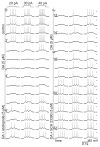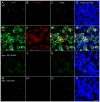Dopamine and full-field illumination activate D1 and D2-D5-type receptors in adult rat retinal ganglion cells
- PMID: 22678972
- PMCID: PMC3538137
- DOI: 10.1002/cne.23159
Dopamine and full-field illumination activate D1 and D2-D5-type receptors in adult rat retinal ganglion cells
Abstract
Dopamine can regulate signal generation and transmission by activating multiple receptors and signaling cascades, especially in striatum, hippocampus, and cerebral cortex. Dopamine modulates an even larger variety of cellular properties in retina, yet has been reported to do so by only D1 receptor-driven cyclic adenosine monophosphate (cAMP) increases or D2 receptor-driven cAMP decreases. Here, we test the possibility that dopamine operates differently on retinal ganglion cells, because the ganglion cell layer binds D1 and D2 receptor ligands, and displays changes in signaling components other than cAMP under illumination that should release dopamine. In adult rat retinal ganglion cells, based on patch-clamp recordings, Ca(2+) imaging, and immunohistochemistry, we find that 1) spike firing is inhibited by dopamine and SKF 83959 (an agonist that does not activate homomeric D1 receptors or alter cAMP levels in other systems); 2) D1 and D2 receptor antagonists (SCH 23390, eticlopride, raclopride) counteract these effects; 3) these antagonists also block light-induced rises in cAMP, light-induced activation of Ca(2+) /calmodulin-dependent protein kinase II, and dopamine-induced Ca(2+) influx; and 4) the Ca(2+) rise is markedly reduced by removing extracellular Ca(2+) and by an IP3 receptor antagonist (2-APB). These results provide the first evidence that dopamine activates a receptor in adult mammalian retinal neurons that is distinct from classical D1 and D2 receptors, and that dopamine can activate mechanisms in addition to cAMP and cAMP-dependent protein kinase to modulate retinal ganglion cell excitability.
Copyright © 2012 Wiley Periodicals, Inc.
Conflict of interest statement
No identified conflicts.
Figures








Similar articles
-
Inhibition of adult rat retinal ganglion cells by D1-type dopamine receptor activation.J Neurosci. 2009 Nov 25;29(47):15001-16. doi: 10.1523/JNEUROSCI.3827-09.2009. J Neurosci. 2009. PMID: 19940196 Free PMC article.
-
A dopamine- and protein kinase A-dependent mechanism for network adaptation in retinal ganglion cells.J Neurosci. 2001 Nov 1;21(21):8624-35. doi: 10.1523/JNEUROSCI.21-21-08624.2001. J Neurosci. 2001. PMID: 11606650 Free PMC article.
-
Suppression of outward K(+) currents by activating dopamine D1 receptors in rat retinal ganglion cells through PKA and CaMKII signaling pathways.Brain Res. 2016 Mar 15;1635:95-104. doi: 10.1016/j.brainres.2016.01.039. Epub 2016 Jan 27. Brain Res. 2016. PMID: 26826585
-
Dopamine receptor heteromeric complexes and their emerging functions.Prog Brain Res. 2014;211:183-200. doi: 10.1016/B978-0-444-63425-2.00008-8. Prog Brain Res. 2014. PMID: 24968781 Review.
-
The peripheral dopaminergic system: morphological analysis, functional and clinical applications.Ital J Anat Embryol. 2002 Jul-Sep;107(3):145-67. Ital J Anat Embryol. 2002. PMID: 12437142 Review.
Cited by
-
Fixation strategies for retinal immunohistochemistry.Prog Retin Eye Res. 2015 Sep;48:181-202. doi: 10.1016/j.preteyeres.2015.04.001. Epub 2015 Apr 17. Prog Retin Eye Res. 2015. PMID: 25892361 Free PMC article. Review.
-
Dopamine D1 and D4 receptors contribute to light adaptation in ON-sustained retinal ganglion cells.J Neurophysiol. 2021 Dec 1;126(6):2039-2052. doi: 10.1152/jn.00218.2021. Epub 2021 Nov 24. J Neurophysiol. 2021. PMID: 34817291 Free PMC article.
-
The D₁ dopamine receptor agonist, SKF83959, attenuates hydrogen peroxide-induced injury in RGC-5 cells involving the extracellular signal-regulated kinase/p38 pathways.Mol Vis. 2012;18:2882-95. Epub 2012 Dec 1. Mol Vis. 2012. PMID: 23233790 Free PMC article.
-
D2-like receptor activation does not initiate a brain docosahexaenoic acid signal in unanesthetized rats.BMC Neurosci. 2014 Oct 30;15:113. doi: 10.1186/1471-2202-15-113. BMC Neurosci. 2014. PMID: 25359512 Free PMC article.
-
Moniliform deformation of retinal ganglion cells by formaldehyde-based fixatives.J Comp Neurol. 2015 Mar 1;523(4):545-64. doi: 10.1002/cne.23689. Epub 2014 Nov 6. J Comp Neurol. 2015. PMID: 25283775 Free PMC article.
References
-
- Abdel-Majid RM, Tremblay F, Baldridge WH. Localization of adenylyl cyclase proteins in the rodent retina. Mol Brain Res. 2002;101:62–70. - PubMed
-
- Berrera M, Dodoni G, Monterisi S, Pertegato V, Zamparo I, Zaccolo M. A toolkit for real-time detection of cAMP: insights into compartmentalized signaling. Handb Exp Pharmacol. 2008;186:285–298. - PubMed
-
- Bjelke B, Goldstein M, Tinner B, Andersson C, Sesack SR, Steinbusch HW, Lew JY, He X, Watson S, Tengroth B, Fuxe K. Dopaminergic transmission in the rat retina: evidence for volume transmission. J Chem Neuroanat. 1996;12:37–50. - PubMed
-
- Brainard GC, Morgan WW. Light-induced stimulation of retinal dopamine: a dose-response relationship. Brain Res. 1987;424:199–203. - PubMed
-
- Brann MR, Young WS., III Dopamine receptors are located on rods in bovine retina. Neurosci Lett. 1986;69:221–226. - PubMed
Publication types
MeSH terms
Substances
Grants and funding
LinkOut - more resources
Full Text Sources
Miscellaneous

